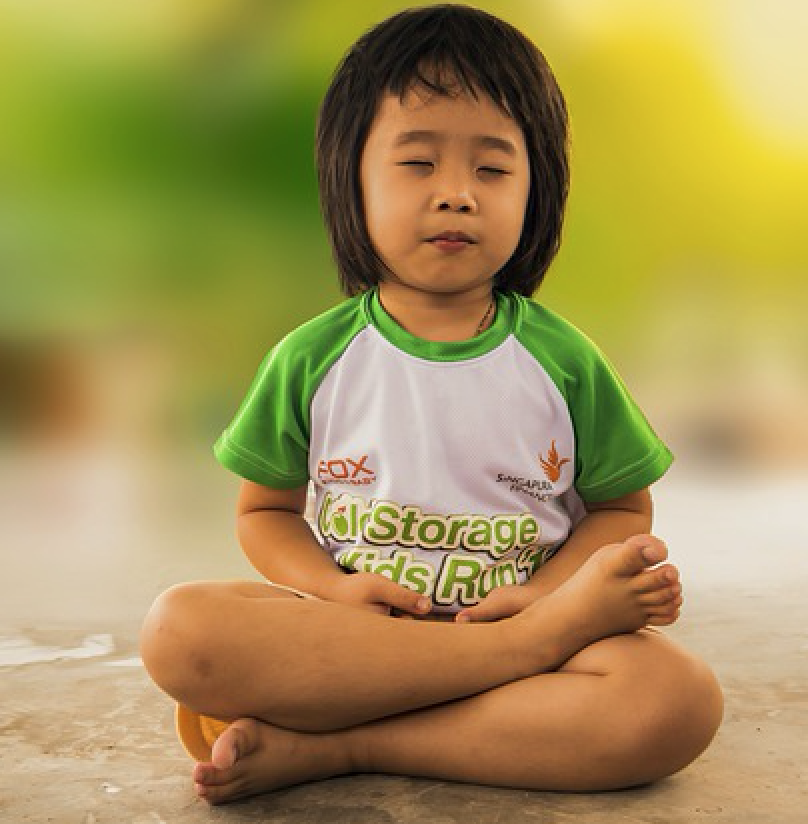Six Simple Mindfulness Practices for Kids with Autism
The practice of quieting the mind, otherwise known as mindfulness, is increasingly being practiced across the board – from Google executives to classrooms as a replacement to detention (Bloom, 2016). Mindfulness specifically refers to the practice of paying attention to the present moment non-judgmentally. Observation of our thoughts and feelings allows us to better understand our emotions and react rationally to negative situations.

FREE Download: Soles of the Feet Behavior Intervention Technique
Imagine snacking on a bag of chips. We then think about yesterday’s meeting, or all the dishes that need to be washed. Eventually, without even noticing, a few chips turn into half of the bag. Our minds are constantly wandering, ruminating on anything but the present, which can lead to increased anxiety or depression. This is where mindfulness comes in. Despite all the recent buzz, mindfulness is backed by hard science: the practice has been shown to not only reduce stress, depression, and aggression but also change brain regions associated with emotional regulation, introspection, and awareness (Holzel et al., 2011).
 Although most of the research has been done on typically developing adults, a new body of work has shed light on the benefits of mindfulness in children with Autism. Aggression, an especially challenging behavior, has been an important behavior of study in the scope of mindfulness techniques. In contrast to the current behavioral and psychopharmacological interventions for aggressive behaviors, mindfulness-based interventions empower individuals to develop self-management strategies to regulate their challenging behaviors. In a longitudinal study and intervention, researchers had adolescents with autism learn the “Soles of the Feet Procedure,” which involved shifting attention from the emotional trigger to the soles of their feet (see below). Aggressive acts were significantly reduced from 14-20 per week to 4-6 per week after the 3-year follow up period (Singh et al., 2011).
Although most of the research has been done on typically developing adults, a new body of work has shed light on the benefits of mindfulness in children with Autism. Aggression, an especially challenging behavior, has been an important behavior of study in the scope of mindfulness techniques. In contrast to the current behavioral and psychopharmacological interventions for aggressive behaviors, mindfulness-based interventions empower individuals to develop self-management strategies to regulate their challenging behaviors. In a longitudinal study and intervention, researchers had adolescents with autism learn the “Soles of the Feet Procedure,” which involved shifting attention from the emotional trigger to the soles of their feet (see below). Aggressive acts were significantly reduced from 14-20 per week to 4-6 per week after the 3-year follow up period (Singh et al., 2011).
Additionally, mindfulness techniques have been shown to improve parent-child relationships and significantly reduce parental stress, improve parental wellbeing and overall health after just a few weeks. This parental change in behavior has the reciprocal effect of reducing stress and anxiety among their kids (Keenan-Mount, Albrecht, & Waters, 2016). In addition to parents, mindfulness training can allow teachers to better regulate their reactions to stressful classroom situations and manage the social, emotional, and educational needs of their students with Autism Spectrum Disorder (ASD). A five-week mindfulness teacher training intervention introduced stress management and relaxation techniques as well as the application of mindfulness techniques to teaching. The training not only improved teacher’s self-efficacy beliefs but also allowed teachers to better cope with challenging situations (Benn et al., 2012).
Therefore, mindfulness practices may be a viable technique in not only improving behavioral and cognitive responses in those with ASD, but also the overall well-being of their caregivers. Although mindfulness may seem like foreign territory, incorporating mindful practices into daily life can be quite simple.
Here are six simple mindful practices you can introduce to your child (and yourself!)
-
Bell Listening Exercise:
Ring a bell, either a physical bell or one from an App or online, and ask your kid to close their eyes and listen to the vibration of the bell. Tell them to raise their hand once the ringing stops and pay attention to any other sounds they hear for about another minute. This is a simple but powerful exercise that shifts one’s attention to the present moment and the surroundings.
- Bedtime Mindfulness: Ask your child to lie in their bed, close their eyes, and bring their attention to various parts of their body. Start at the toes and slowly move up to the head. Here are some scripts that you can follow: 1, 2. This is a calming method to return to one’s body at the end of the day and develop a sense of gratitude for their body.
- Mindful Walks: Stroll through your neighborhood in silence for a few minutes and have your child pay attention to all the sounds they hear. Then have them report back what they heard. You can also guide them to other sensations such as the breeze through their hair or the crunching of the leaves as they walk. If your child is particularly active, you may ask them to run or skip and notice their increased heartbeat or breath.

- Mindful breathing and meditation: Ask your child to close their eyes and sit comfortably. Direct their attention to the sensation of breathing in and out. Ask them to put their hands on their stomach and feel the rise and fall of each breath. You can do this for about five cycles then guide them to any present feelings or thoughts. Tell them to observe those thoughts and feelings and let them go like a balloon. You can repeat this as many times as needed or possible. Here is a guided meditation.
- Soles of the Feet: This technique was developed by researchers to manage angst, anger and aggression. When faced with emotionally arousing situations, you can teach your child to redirect their attention and awareness to a neutral part of the body such as the soles of their feet. This technique helps calm and clear one’s mind during stressful and arousing situations. Here is a free download of a short step by step guide to the Soles of the Feet exercise to practice with your child.
- Glitter Jar: Fill a clear jar with water, some glitter, and glycerin or baby oil. A snow globe would be equally great for this activity. Particularly when your child is having a stressful day, ask them to shake up the jar and watch as the glitter settles after swirling chaos. This technique allows for a powerful metaphor that relates the internal state of the mind to a visual object. Here is a script that can be followed and adapted.
Research and Resources
Recently, a good amount of research and publication has focused on this subject. The following is a list of additional resources:
- Self-Regulation and Mindfulness: Over 82 Exercises & Worksheets for Sensory Processing Disorder, ADHD, & Autism Spectrum Disorder by PESI Publishing & Media
- CBT Toolbox for Children and Adolescents: Over 200 Worksheets & Exercises for Trauma, ADHD, Autism, Anxiety, Depression & Conduct Disorders by PESI Publishing & Media
- A Mindfulness Intervention for Children with Autism Spectrum Disorders: New Directions in Research and Practice (Mindfulness in Behavioral Health) by Springer
- Flexible and Focused: Teaching Executive Function Skills to Individuals with Autism and Attention Disorders (Critical Specialties in Treating Autism and other Behavioral Challenges) by Academic Press
- Mindfulness Certification Training for Individuals and Coaches
References:
“Instead of Detention these Students get Meditation”
Benn, R., Akiva, T., Arel, S., & Roeser, R. W. (2012). Mindfulness training effects for parents and educators of children with special needs. Developmental Psychology, 48(5), 1476.
Hölzel, B. K., Lazar, S. W., Gard, T., Schuman-Olivier, Z., Vago, D. R., & Ott, U. (2011). How does mindfulness meditation work? Proposing mechanisms of action from a conceptual and neural perspective. Perspectives on psychological science, 6(6), 537-559.
Keenan-Mount, R., Albrecht, N. J., & Waters, L. (2016). Mindfulness-based approaches for young people with Autism Spectrum Disorder and their caregivers: Do these approaches hold benefits for teachers? Australian Journal of Teacher Education, 41(6), 5.
Singh, N. N., Lancioni, G. E., Manikam, R., Winton, A. S., Singh, A. N., Singh, J., & Singh, A. D. (2011). A mindfulness-based strategy for self-management of aggressive behavior in adolescents with autism. Research in Autism Spectrum Disorders, 5(3), 1153-1158.

Krupa Patel
Krupa Patel recently received her B.S. in Neuroscience from the University of Southern California and is currently a graduate student at the Harvard Graduate School of Education in the Mind, Brain and Education program. She has previously taught STEM in elementary classrooms and is an advocate for inclusive education. She has also worked at a nonprofit aimed at supporting individuals with mental illnesses in rural areas and de-stigmatizing mental illness. Her specific interests lie in the intersection between neuroscience and developmental disabilities and hopes to pursue a career in Pediatric Psychiatry or Neurology.







